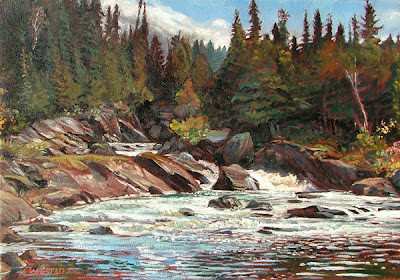Ivanhoe "The Chute" (oil on canvas 12 x 16) Sold
23 September finds me painting on the east shore of the Ivanhoe River below The Chutes, 16 km north of Foleyet, Ontario. Here the Ivanhoe spills, foaming, across a gneiss ledge above its clay riverbed. Behind me, runs around an island in Cedar/Poplar woods.
This is a complex painting. The composition is made of many little parts that need to fit together just right! I'm glad that I set up the shelter so I could keep painting through
the frequent rain showers. Sometimes low clouds roll over, and sometimes the sky is mostly blue! We've been in this interesting weather pattern for several days now.
The Chute is another of the wild free-running waterfalls that is threatened by a proposed hydroelectric dam. I am painting as many of these as I can, to make people aware of their vulnerability and also to record what they look like now, in case they may be bound up in cement and steel, with their upstream reaches flooded and the river life downstream damaged by "pulsing" water levels.
At the edge of the river, just to the left of the falls, Eastern White Cedars picturesquely sprawl over boulders above the clay bank. If I had time to do a second painting here, I'd paint those trees.
Exploring downstream past a grove of big Cedars, Fred captured a young Toad with a reticulated pattern of black and gold, in Horsetail at the waters edge. He continued down past wide clay flats to a shoreline tangle of Dogwood backed by Black Ash trees, and there was a concentration of Lampsilis radiata shells (the kind he calls "subspecies siliquoidea") at a Beaver trackway up into the Dogwood - 90 pairs of shells counted… he thinks that Beavers might be eating clams!
The edge of the Dogwood is marked by elegant tall Swamp Milkweed in fluff, and there he collected some of the widespread Pondweed from the shallows, and began to pick up floating shells - Helisoma campanulatum (Bell-mouth Ramshorn) and Lymnaea stagnalis (Great Pond Snail) in modest numbers. His sample included 20 shells of Lymnaea stagnalis (Great Pond Snail) , one small Physa (Tadpole Snail) shell and lots of Helisoma campanulatum (Bell-mouth Ramshorn) - these seem to mature at a very small size here.
Then as we were packing up to leave, he went to the campground to measure the big Cedars around grassy/rutted campsite area. The four largest measured -
67 cm DBH - healthy with spikes & tentpeg hammered into trunk,
65.5 cm DBH - snapped off at 2.3 m height with spikes hammered into trunk,
77 cm DBH - sick with most of crown dead and only a little green foliage,
65 cm DBH - very healthy with no spikes driven into trunk - a bit away from the campsite.
Fred writes, "These are noteble for the smooth deep-grooved or pleated character of their bark - nobody and no-beast has abraded or torn these up for a long time. - other trees here are a few big Picea glauca (White Spruce) and fairly big Populus balsamifera (Balsam Poplar) with half-shed ragged crowns. Matteuccia struthiopteris (Ostrich Fern) down slope under some of these trees, and other ferns in the woods around."
67 cm DBH - healthy with spikes & tentpeg hammered into trunk,
65.5 cm DBH - snapped off at 2.3 m height with spikes hammered into trunk,
77 cm DBH - sick with most of crown dead and only a little green foliage,
65 cm DBH - very healthy with no spikes driven into trunk - a bit away from the campsite.
Fred writes, "These are noteble for the smooth deep-grooved or pleated character of their bark - nobody and no-beast has abraded or torn these up for a long time. - other trees here are a few big Picea glauca (White Spruce) and fairly big Populus balsamifera (Balsam Poplar) with half-shed ragged crowns. Matteuccia struthiopteris (Ostrich Fern) down slope under some of these trees, and other ferns in the woods around."




Yet again another beautiful masterpiece Aleta! Thank you!
ReplyDeleteThis beautiful waterfall and over 80 km of riverine ecosystem will be destroyed if this government and Xeneca Power Development Inc. have their way. As a matter of fact it is our tax dollars that will subsidize these projects by way of access to Crown land, government grants, and peaking bonuses. Many of these projects are actually being backed and paid for through the OPSEU Pension Fund.
This Project has already been through the gauntlet once, when Xeneca issued its Environmental Report in September of last year. The Minister of Environment's office rejected this report because it didn't meet the requirements of the Class Environmental Assessment Act for Waterpower. This company was sent back to do more planning, and will resubmit its new Environmental Report (ER) sometime later this year if rumors are correct. This new ER will also include Triple Falls, as it has been determined they are hydraulically connected and must be considered as one project.
Lake Sturgeon is an endangered species, and is present at this project site. It is uncertain how the constant pulsing and surging of water levels and flow velocity will impact their habitat and population numbers, but it is certain to place more pressure on their chances of survival.
There are many local outfitters and businesses who rely on the natural beauty of the Ivanhoe River for their economic survival, and this would all be jeopardized if this area is allowed to be destroyed. It will be private developers who will reap the rewards - not the local people. The power that will be produced from these projects is not needed, and will be sold at a loss - the taxpayers' loss - to other provinces or the US.
For more information about this project see my comments on Triple Falls.